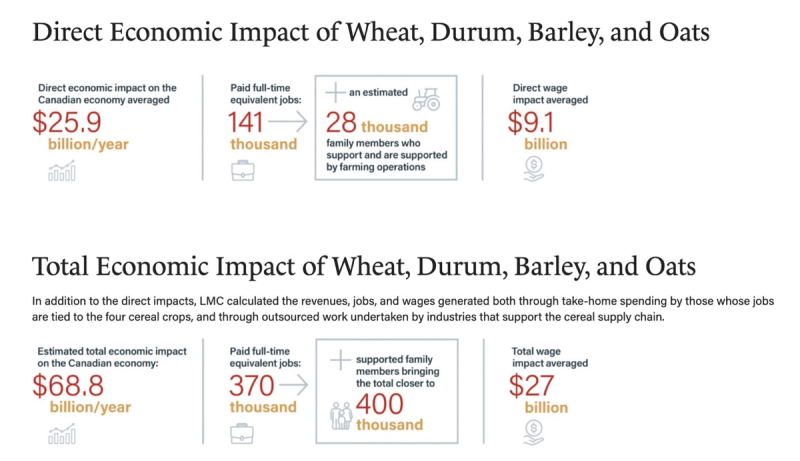
Managing Pest and Disease Challenges in Western Canada’s Cereal Crops
2024-11-25
his blog delves into the pest and disease challenges faced by cereal crops in Western Canada and the effective strategies used to tackle them.
Cereal crop production in Western Canada plays a pivotal role in shaping the region’s agricultural landscape, as well Canada’s agriculture industry. Canada’s cereals sector leads the country’s agriculture exports with annual exports to over 80 countries with an estimated value of $9.8 billion CAD, according to Cereals Canada.
The cereals industry had an estimated total impact of $68.8 billion, including more than 370,000 Canadian jobs, and $27 billion in wages, according to a new study funded by Cereals Canada. The report finds the cereals industry has a greater economic impact than the aerospace and rail transportation industries; it employs more people than telecom and is even bigger than canola and beef.

Source: Cereals Canada
The bulk of cereal grain production takes place in Western Canada, while much of the later-stage processing takes place in the east. The vast prairies of Alberta, Saskatchewan, and Manitoba provide fertile ground for the cultivation of cereals like wheat, barley, and oats.

Source: Cereals Canada
However, the journey from planting to harvest is not without its challenges. One of the most significant hurdles that farmers face is managing pests and diseases that can threaten crop health and yield.
In this blog, we will explore the various pest and disease challenges in Western Canada’s cereal crops and the strategies employed to combat them.
Pest Challenges
- Wheat Stem Sawfly: The wheat stem sawfly (Cephus cinctus) is a formidable pest in Western Canada, primarily targeting wheat crops. Adult sawflies lay their eggs on the stems of wheat plants, and the larvae bore into the stem, weakening it and causing the plant to lodge or fall over. This not only reduces yield but also makes harvesting more challenging. Farmers combat the wheat stem sawfly through integrated pest management (IPM) practices. These include crop rotation, as the pest prefers wheat, so planting alternative crops in the rotation can disrupt its life cycle. Additionally, early seeding and selecting wheat varieties with resistance traits can help mitigate damage.
- Aphids: Aphids are tiny, sap-sucking insects that can infest cereal crops, including barley and wheat. They damage plants by depleting their sap, which can result in stunted growth and reduced yield. Aphids are also vectors for barley yellow dwarf virus (BYDV), which can further harm crops. To control aphid populations, farmers often rely on beneficial insects like ladybugs and parasitoid wasps that prey on aphids. Insecticide applications are used when aphid populations reach economic thresholds. Planting disease-resistant crop varieties can also help reduce the risk of BYDV transmission.
- Wireworms: Wireworms are soil-dwelling pests that belong to the click beetle family. These slender, segmented larvae can vary in size and color but are typically brown or yellow. They are voracious feeders and primarily target the roots of cereal crops, making them a significant concern for farmers. Wireworm damage can have several adverse effects on cereal crops including reduced stand establishment, stunted growth, and crop health issues.
- Cereal Leaf Beetles: Cereal Leaf Beetles (Oulema melanopus) are small, metallic-blue insects that pose a significant threat to cereal crops in Western Canada. These beetles, measuring approximately 4 to 5 millimeters in length, are known for their distinctive appearance. They have shiny blue bodies with black stripes running lengthwise. Signs of their presence are often evident through the characteristic damage they inflict on cereal plants. Both larval and adult Cereal Leaf Beetles feed on the leaves of crops like wheat, barley, and oats. Larvae create elongated, window-like holes in the leaves, while adult beetles consume leaf tissue between veins, leaving a skeletonized appearance. Recognizing these signs is crucial for early detection and effective pest management in cereal fields.
Disease Challenges
- Fusarium Head Blight (FHB): Fusarium head blight, caused by various Fusarium species, is a devastating disease in cereal crops, especially wheat and barley. It infects the heads of plants, leading to shriveled kernels, mycotoxin production, and reduced grain quality. Preventing FHB involves implementing cultural practices like crop rotation and selecting resistant varieties. Fungicide applications are crucial for managing the disease, with timing being a critical factor. Applying fungicides during the flowering stage can help reduce infection rates significantly.
AgraCity’s FusaroTM gives excellent protection from fusarium head blight (FHB). Fusaro has same active as Prosaro® and is tank-mixable with foliar products. It has preventative and curative properties; and protects grade and quality while increasing yield. Know more about Fusaro
- Cereal Rusts: Rust diseases are a group of fungal diseases that affect cereal crops like wheat, barley, and oats. They get their name from the characteristic rusty or reddish-brown pustules that appear on infected plant tissues. Two common types of rust diseases that impact cereal crops in Western Canada are stem rust and leaf rust.
- Stem Rust (Puccinia graminis): Stem rust primarily affects wheat crops. It’s characterized by reddish-brown pustules that develop on the stems and leaves of infected plants. Stem rust can be particularly destructive, as it weakens the plant’s structural integrity, leading to lodging (plants falling over) and reduced grain quality. Severe stem rust infections can cause significant yield losses. To manage stem rust, farmers often rely on resistant wheat varieties and timely fungicide applications.
- Leaf Rust (Puccinia triticina): Leaf rust is another common rust disease that targets cereal crops. It appears as small, round, reddish-brown pustules on the leaves. While leaf rust is generally less damaging than stem rust, it can still reduce crop yields, especially in susceptible wheat and barley varieties. Like stem rust, leaf rust can be managed through resistant crop varieties and fungicide applications when necessary.
- Stripe Rust: Stripe rust (Puccinia striiformis) is a fungal disease that presents as yellow to orange stripes on leaves and can reduce photosynthesis, leading to yield loss. Managing stripe rust involves planting resistant wheat varieties when possible. Fungicides can also be applied preventively or curatively to control the disease. Monitoring and timely intervention are essential to prevent its rapid spread.
AgraCity’s Tornado® helps control leaf diseases in cereal crops at an affordable price. Tornado, which has Same active as Folicur®; can be used in all soil zones with no re-cropping restrictions. Tornado also prevents fusarium head blight (FHB) in wheat. Know more about Tornado
Integrated Pest and Disease Management
Integrated pest and disease management (IPM and IDM) approaches are vital for addressing these challenges. These holistic strategies aim to minimize the use of pesticides and focus on long-term sustainability:
- Crop Rotation: Crop rotation is a fundamental practice in Western Canadian agriculture. It disrupts the life cycles of pests and diseases by changing the host crop each season. This reduces the build-up of pathogens and pests in the soil
- Resistant Varieties: Planting resistant crop varieties is an effective way to combat both pests and diseases. Western Canadian farmers continually adopt new varieties with improved resistance traits to enhance crop resilience.
- Monitoring and Scouting: Regular field scouting and monitoring for pests and diseases allow farmers to detect issues early. By identifying problems in their infancy, growers can implement timely interventions, such as targeted pesticide applications.
- Beneficial Insects: Encouraging the presence of beneficial insects, like parasitoid wasps and ladybugs, helps control pest populations naturally. Some farmers even release these insects into their fields to support biological control.
- Fungicides and Insecticides: When pest or disease pressures reach economic thresholds, farmers may turn to chemical solutions. However, the judicious use of pesticides is essential to minimize environmental impact and preserve beneficial organisms.
Challenges and Considerations
While fungicides and insecticides are valuable tools in cereal crop pest and disease management, their use requires careful consideration. Growers face several challenges:
- Resistance Management: Prolonged and extensive use of fungicides and insecticides can lead to the development of resistance in target pests. Implementing resistance management strategies, such as rotating active ingredients, is crucial.
- Environmental Impact: The environmental impact of pesticide use, including the potential harm to non-target organisms and water quality, is a growing concern. Integrated approaches aim to minimize these effects.
- Regulatory Compliance: Growers must adhere to pesticide regulations and label instructions to ensure safe and legal use.
- Cost-Benefit Analysis: The cost of pesticide applications must be weighed against the potential economic benefits of increased yields and reduced losses.
Future of Pest and Disease Management
The world of cereal crop pest and disease management is evolving rapidly. Research and innovation continue to drive the development of new, more targeted pesticides and environmentally friendly alternatives. Additionally, digital technologies and precision agriculture tools enable growers to monitor their fields and make data-driven decisions about pesticide applications, optimizing their effectiveness.
Managing pest and disease challenges in Western Canada’s cereal crops requires a multifaceted approach. Farmers employ a combination of cultural practices, resistant varieties, and, when necessary, chemical interventions to protect their crops. Integrated pest and disease management strategies ensure the sustainability of cereal crop production while minimizing environmental impacts. By staying informed about emerging threats, adopting integrated pest management strategies, and embracing the latest advancements in pesticide technology, growers can continue to protect their crops while promoting sustainable and profitable farming practices.